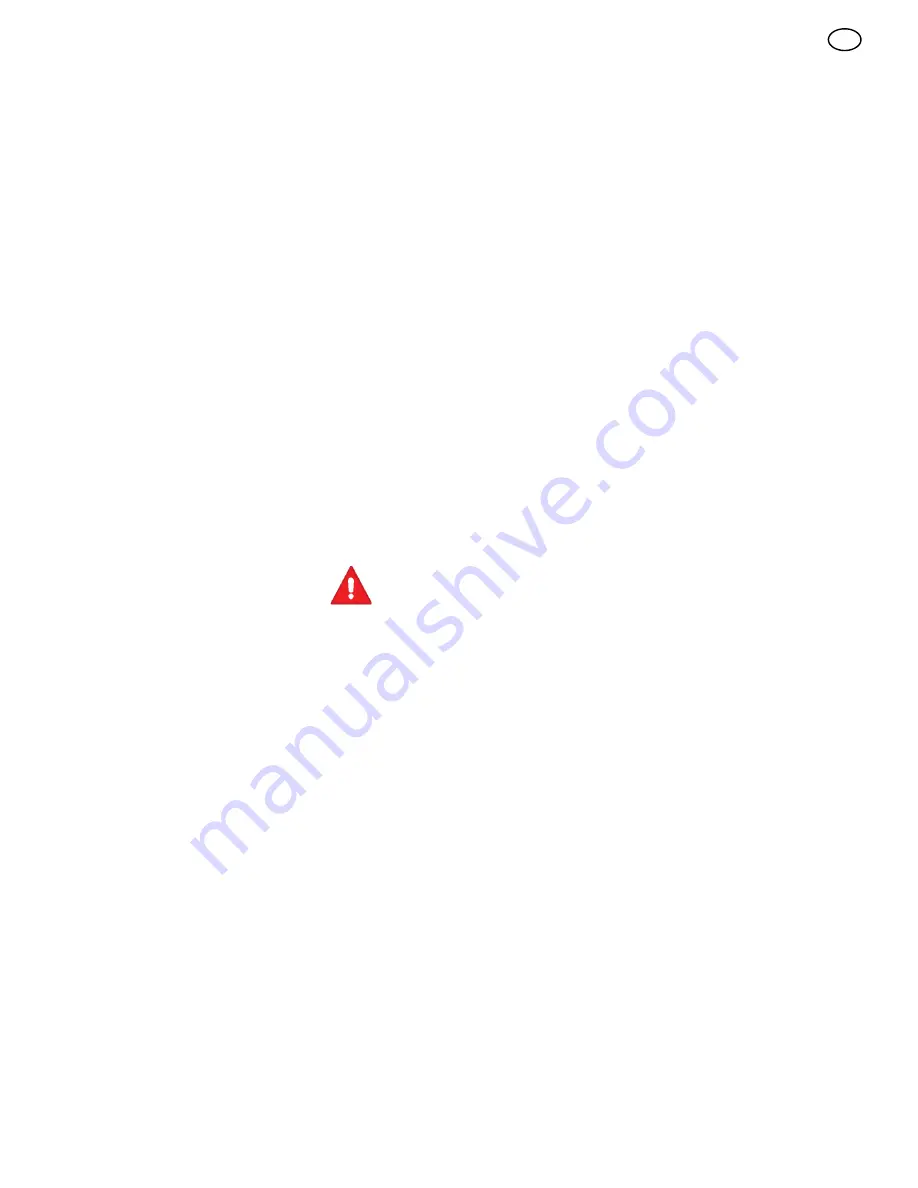
GB
13
1740281
5. Remove the old
drive belt (1).
6. To install the new
drive belt (1),
reverse the
above steps.
7. Make sure the
drive belt (1)
is seated prop-
erly on the pulleys.
8.
(Figure 13)
Set the
belt guide (4)
to 3/32”
(2mm) clearance.
NOTE: When the auger control lever is
engaged, the belt guide (4) must be 3/32”
(2mm) from the drive belt (1).
9. Install belt cover. See “How To Remove The
Belt Cover”.
How To Replace The Auger
(Figure 14)
1. Remove the belt cover. See “How To Re-
move The Belt Cover”.
2. Remove the drive belt. See “How To Replace
The Drive Belt”.
3. Remove the
auger pulley (1)
from the auger
shaft (threads are left hand; turn clockwise to
remove).
4. To keep the
auger (6)
from rotating, set a
2”x4” piece of
wood (2)
on the center
paddle (3)
to secure
auger (6).
5. Remove the fasteners from the
bearing as-
sembly (4)
. Remove the
bearing assembly
(4)
from the
auger housing (5).
6. Slide the
auger (6)
out of the bearing assem-
bly on the right side of the snow thrower.
7. Tip the
auger (6)
enough to allow the
auger
(6)
to slide out of the
auger housing (5).
8. To install
auger (6),
reverse the above steps.
How To Adjust The Brake Pad
(Figure 15)
IMPORTANT: An adjustment is only neces-
sary if the brake pad has become loose or
has been removed. To adjust, proceed as
follows:
1. Remove the top cover. See “How To Remove
The Top Cover”.
2. Remove the belt cover. See “How To Re-
move The Belt Cover”.
3. Tie the auger drive lever to the handle. This
will engage the drive system.
4. Loosen the screw and nut that secure the
brake pad arm (1).
5. Set the clearance between the
brake pad (2)
and the
drive belt (3)
to
1/8 inch (3mm)
.
6. Tighten the screw and nut that secure the
brake pad arm (1)
.
7. Connect the wire to the spark plug.
How To Replace The Spark Plug
NOTE: This spark ignition system meets all
requirements of the Canadian Interference--
Causing Equipment Regulations.
NOTE: This engine complies with all current
Australian and New Zealand limitations elec-
tromagnetic interference.
The spark plug is housed in the engine compart-
ment under the top cover and cannot be seen
under normal conditions.
1.
(Figure 16)
Open the spark plug
access door
(1)
on the control panel.
2. The spark plug and wire are now visible.
3. Remove the spark plug wire.
4. Clean the area around the spark plug base to
prevent dirt from entering the engine when the
spark plug is removed.
5. Remove the spark plug.
6. Check the spark plug. If the spark plug is
cracked, fouled or dirty, it must be replaced .
7.
(Figure 17)
Set the gap between the elec-
trodes of the new spark plug at .030 inch. Next,
install the spark plug in the cylinder head and
firmly tighten. Recommended torque is 18 to
20 foot pounds.
How To Prepare The Snow Thrower For
Storage
WARNING: Do not remove petrol
while inside a building, near a fire,
or while you smoke. petrol fumes
can cause an explosion or a fire.
1. Drain the fuel tank.
2. Let the engine run until it is out of petrol.
3. Remove the spark plug from the cylinder.
Pour one ounce of oil into the cylinder. Slow-
ly pull the recoil--start grip so that the oil will
protect the cylinder. Install a new spark plug
in the cylinder.
4. Thoroughly clean the snow thrower.
5. Lubricate all lubrication points. See the Main-
tenance section.
6. Be sure that all nuts, bolts and screws are
securely fastened. Inspect all visible moving
parts for damage, breakage and wear. Re-
place if necessary.
7. Cover the bare metal parts of the blower
housing and auger with spray rust preventa-
tive lubricant.
8. Put the unit in a building that has good ven-
tilation.
9. If the machine must be stored outdoors,
block up the snow thrower to be sure the en-
tire machine is off the ground.
10.Cover the snow thrower with a suitable pro-
tective cover that does not retain moisture.
Do not use plastic.
How To Order Replacement Parts
The replacement parts are shown either on the
back pages of this Instruction Book or in a
separate Parts List Book.
Use only manufacturer’s authorized or approved
replacement parts. The letter placed on the end
of the part number denotes the type of finish for
the part, C for chrome, Z for zinc, a PA for
purchased assembly. It is important that you
include this when ordering a part. Do not use
attachments or accessories not specifically
recommended for this unit. In order to obtain
proper replacement parts you must supply the
model number (see nameplate).
Replacement parts, except for the engine, trans-
mission, transaxle or differential, are available
from the store where the mower was purchased
or a service shop recommended by the store.
Warranty service is available only through Autho-
rized Service Dealers. Locate your nearest dealer
in our locator map at www.murray.com.
Replacement parts for the engine, transaxle, or
transmission, are available from the
manufacturer’s authorized service center found
in the yellow pages of the telephone directory.
Also, see the individual engine or transmission
warranties to order replacement parts.
When ordering the following information is
required:
(1) The Model Number
(2) Serial Number
(3) Part Number
(4) Quantity






































